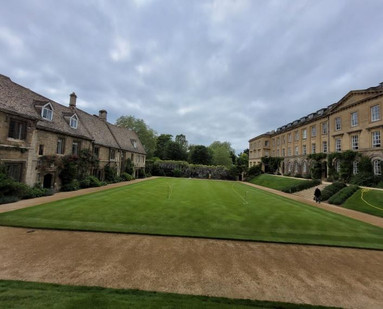An Odyssey through the corridors of Knowledge | Anestin Chi
- Open Dreams

- Jun 4, 2023
- 4 min read
On May 30th, 2023, Hornby Scholars at the University of Warwick, in the company of Pr. Richard Smith, set out on a journey to a world of scholarly excellence – the Oxford University Press (OUP) and the University of Oxford. OUP is the largest University Press in the world, publishing world-class research, educational and English Language teaching resources.

As scholars stepped into the hallowed halls of OUP, a place that fuels the passion for learning, a sense of reverence and excitement filled them. An OUP team welcomed scholars on arrival and took them on a guided tour.

As scholars walked through the halls of OUP, a knowledgeable guide weaved captivating narratives about the history of the institution.

OUP is the second oldest university press after “the other place”, an appellation coined within Oxford Circle to refer to the University of Cambridge. From the late 1800s, OUP began to expand significantly. Currently, OUP is a global organization, publishing more than six thousand titles a year, in 70 languages, in 53 countries in the world. Although publications include dictionaries, English language teaching materials, children’s books, journals, scholarly monographs, printed music, higher education textbooks, and school books, OUP is famous for publishing the Bible (as the University of Oxford was originally founded to train clergymen) and what is now known as the Oxford Advanced Learner’s Dictionary, initially compiled by A.S. Hornby.


Yes, you guessed right! – The connection between Hornby scholars and A.S. Hornby. A.S. Hornby was an English grammarian and lexicographer, whose life and career have had a profound and enduring influence on English Language teaching across the globe.
A.S. Hornby founded the Hornby Educational Trust in 1961. To date, royalties from the dictionary are used to
sponsor English Language teachers and projects across the globe.
A walk through the OUP museum whispers tales of wisdom and knowledge waiting to be discovered. Scholars had the opportunity to see and touch some old press tools and learn about the origin of upper and lower cases, now used as current English expressions.
Anestin, experimenting with the Stanhope press invented around 1800
After an hour of the OUP museum tour, scholars were treated to lunch. Thereafter, they engaged with OUP experts in discussions and a lecture about the legacy of Albert Sydney Hornby. At the end of the intellectual talk, the scholar received a copy, each, of the newly published 10th edition of the Oxford Advanced Learners Dictionary. Before leaving OUP premises, scholars were granted an interview. This marked the end of the first phase of their journey.

The second phase of the journey was marked by a visit to the University of Oxford. Scholars were taken on the tour by another knowledgeable guide. The first thing scholars got to discover is that the University of Oxford is not a traditional university per se.

The University of Oxford is made up of thirty-nine colleges and five permanent private halls of religious foundation. These colleges and permanent private halls are autonomous within the university. A typical college consists of a dining hall, a chapel, a library, a college bar, and lodgings for students. Students live and attend tutorials in their colleges but attend lectures at central faculties and departments.
Hornby scholars had the pleasure of visiting one of the oldest colleges, Balliol – established in 1263, and also a host of other colleges, amongst which Lady Margaret Hall and Somerville College, which started off as women-only colleges; the Worcester College, founded in 1714 but admitted its first batch of female students in 1979; the prestigious All Souls College, reserved for fellows only.
College buildings are a mix of medieval and modern constructions
The University of Oxford is contentiously the oldest University in the English-speaking world as “the other place” (an appellation coined within Oxford Circle to refer to the University of Cambridge) claims this position too. Hornby scholars learned that the rivalry between Oxford and Cambridge dates back to around 1208 when Cambridge was founded by masters taking refuge from hostile townsmen in Oxford after two masters were hanged by Oxford folks without trial following the mysterious death of a local woman.
The major highlight of this second phase of the trip for Hornby scholars was the Bodleian Library, the main research library of the University of Oxford. The Bodleian Library, which is principally a read-only library (books are not signed out), occupies a group of five buildings. Scholars were treated to the oath that granted access to the library.

The Bodleian Library is one of the oldest libraries in Europe, and in Britain is second in size only to the British Library. Today the Bodleian Library holds over 13 million printed items. What an impressive record! You should probably be wondering how the library got to amass this much. In 1610, Thomas Bodley, who is said to be the brain behind the Bodleian Library, named after him, entered into an agreement with the Stationers’ Company of London for a copy of every book published in England to be deposited in the Bodleian Library. The vast collection covers a plethora of subjects, from literature and history to science and mathematics, offering a treasure trove of information that ignites the thirst for learning. As scholars walked through the Bodleian library buildings, they couldn’t help but feel a profound connection to the countless authors, scholars, and thinkers who have contributed to the world of knowledge.

The Oxford trip was an opportunity for scholars to immerse themselves in the vast ocean of knowledge and to witness the legacy of centuries. It was indeed a memorable journey into the heart of academia. Scholars felt the aura that surrounds the University of Oxford, a place where centuries of scholarly achievements and intellectual prowess converge.

Anestin Chi,
Hornby Scholar 2022/2023















Comments